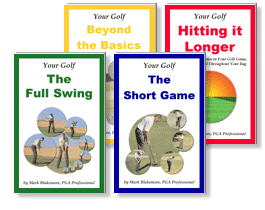All Those Wedges
Wedges and their names and purposes
by Mark Blakemore, PGA Professional
I received a question through the Ask the Pro section about a specific type of wedge, what its name meant and what it was for, which seemed to open the whole can of worms regarding the wide variety of wedges, their names and purposes. So I figured an
article on the topic would be better than just answering the question about one particular wedge.
Wedges come in a huge variety. The reason for this variety is that they perform differently, and some of it is certainly also just marketing. Some wedges are better for playing certain kinds of shots than others. The variables involved, for the
purpose of this discussion, are mainly in the head (loft, sole size and shape, flange size and shape, bounce angle, camber), though the other club specifications (lie angle, club length, shaft flex, grip size, etc.) can also vary, of course.
Typical lofts these days are 48 degrees for a pitching wedge, 56 degrees for a sand wedge, and 60 degrees for a lob wedge. The gap wedge is usually somewhere around 52 degrees and named appropriately, as it fills the "gap" (48 - 56) between
the pitching wedge and the sand wedge. But specifications can vary between manufacturers, so those loft angles are not always exactly the same.
Two common configurations in golfers' bags are a three wedge system (3-wedge system) and a four wedge system (4-wedge system). A three wedge system would typically consist of a pitching wedge, a sand wedge and a lob wedge. A four wedge system would
typically consist of a pitching wedge, a gap wedge, a sand wedge and a lob wedge. Those two arrangements are common, but personal preferences may vary widely.
Depending on the size and shape of the wedge's head it performs certain types of shots well, or not so well. For example, a sand wedge with a large sole and/or a large bounce angle typically works well in thick, soft, deep sand and long grass, but
usually does not work well from the fairway, off of hardpan, or in firmly packed sand. Conversely, a wedge with a fairly thin blade and/or very little bounce works well from the fairway but not from thick fluffy sand or thick rough. But those are
only generalizations; shot situations and player personal preferences vary even more widely than does the array of available wedges. Wedges are also sometimes designed (by head size, weight, sole and edge shape, etc.) to be effective in multiple ways.
So in an attempt to cover the majority of common wedge types and names I offer the following table.
| Name |
Abbreviation |
Common loft and/or description |
| 10 iron |
10 |
47-48, same as pitching wedge |
| Approach Wedge |
A, AW |
Probably same as gap wedge |
| Dual Wedge |
D, DW |
52-54, as in dual-purpose, like gap wedge |
| Equalizer |
E |
46-50, same as pitching wedge |
| Fairway Wedge |
F, FW |
Probably same as gap wedge |
| Gap Wedge |
G, GW |
52 |
| Lob Wedge |
L, LW |
59-60, some as high as 65 |
| M Wedge |
M |
50-60, stands for "muscle" as in muscle-back |
| M/B wedge |
M/B |
56, stands for mid-bounce |
| Pitching Wedge |
P, PW, W |
47-50 |
| Sand Wedge |
S, SW |
55-56, wide variation in shapes and sizes |
Here below are some other wedge names which could mean just about anything, but that probably signify something between a Pitching Wedge and a Lob Wedge.*
Power Wedge
Third Wedge
Utility Wedge
The above list is certainly not comprehensive but should cover the majority of wedges. If you know of another wedge by a major manufacturer that seems like it should be on the list contact me with the name,
abbreviation, loft and/or description and I will include it in the list.
Now, about using those wedges... Having equipment that you like is great. But knowing how to use it is even greater. Developing solid and reliable short game technique is arguably the most important aspect of improving as
a golfer. To learn about and develop your short game skills see my book "The Short Game."
* If you have a wedge of a type or purpose that you cannot identify, or if you'd like to find out how many degrees of loft it has, any reputable local golf professional or club repair person should be able
to help you.

Work on any part of your game with PGA professional Mark Blakemore, author of this website, in person at two locations in the east bay area of San Francisco. Or get the books...
For more golf instruction articles see my
archive of previous golf instruction articles.
Feel free to send me a message to suggest a topic for future articles.
|
![]()



